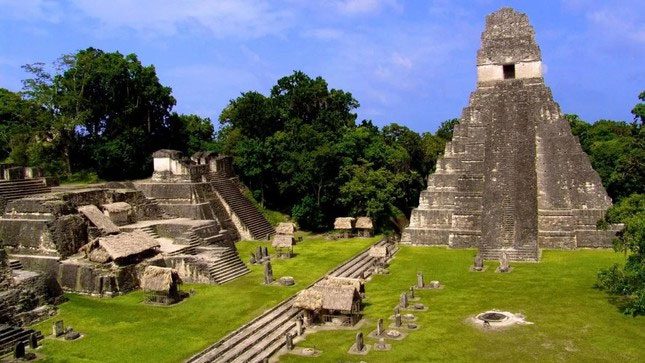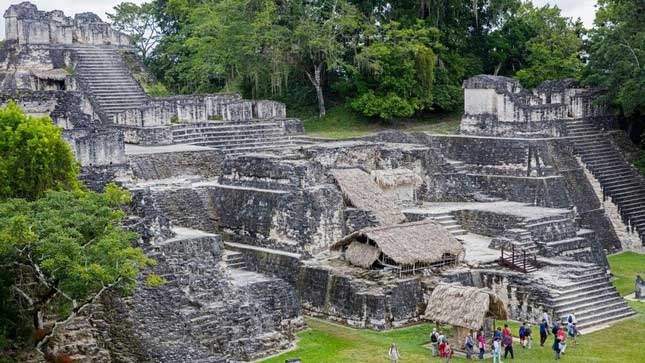Dozens of Maya elite were buried in the temples of Tikal. The ancient city of Tikal, located in present-day Guatemala, thrived from around 600 BC to 900 AD.
Initially a series of small villages, it evolved into a grand Maya city featuring over twenty large pyramids. The Maya ruins of Tikal can be found deep within the jungles of Guatemala.

The ancient city of Tikal discovered in the jungles of present-day Guatemala.
Tikal, One of the Largest Ancient Cities in Central America
“Tikal” is a name in the Maya language meaning “at the waterhole.” In ancient times, it was known as Mutul and served as the center of a powerful Maya kingdom, as noted by archaeologist Robert Sharer, curator of the Penn Museum, in his book “The Ancient Maya, Sixth Edition” (Stanford University Press, 2005). Tikal is one of the largest archaeological sites in Central America and is surrounded by Tikal National Park.
During its peak from 682 to 909 AD, the city spanned at least 130 km2, as John Montgomery, a researcher who has extensively studied the Maya, noted in his writings about the ancient city of Tikal, one of the largest in the Central American region.
To sustain such a large population, the city’s inhabitants developed an intricate water management system to ensure access to water during dry periods, as revealed in a study published in 2012. This system included dams and reservoirs, as well as a sand filtration system used to purify water. It was operational for approximately 1,000 years until the city collapsed in the 10th century.
Like those in other Maya cities, the residents of Tikal used a glyptic writing system inscribed on stone and on a perishable material made from bark (most of which has not survived). Scholars have been able to decipher the writing, along with the archaeological remains of the city, helping them reconstruct much of Tikal’s past.
The Origins of Tikal
Tikal is located in an area of Central America rich in Maya ruins. In 2018, researchers discovered over 60,000 previously unknown Maya structures in Guatemala, including pyramids, residential buildings, and defensive fortifications. They utilized LiDAR (Light Detection and Ranging), which operates by sending laser pulses down to the ground from aircraft. When the pulses reflect back, their wavelengths are measured to create a virtual three-dimensional image of the archaeological sites on the ground.
The first stone buildings at Tikal were constructed around 200 BC, including the “World of the Dead” complex, one of the earliest monumental sites at Tikal, completed around the year 1. The earliest inhabitants of Tikal were the Maya, although they may have been influenced by people from a city called Teotihuacan. The first settlers in Tikal likely spoke a Maya language.
The Influence of Teotihuacan

A part of the ancient city of Tikal discovered.
LiDAR data mapping the Maya city of Tikal revealed an unexcavated structure, a hook-shaped object beneath Mundo Perdido, resembling a pyramid located hundreds of miles away.
Teotihuacan is a city in central Mexico, over 1,000 km away, that flourished from around 100 BC to 600 AD. The influence of this city has been identified in various architectural styles and artifacts found at Tikal, suggesting political influence and possibly control over the city.
Maya writing, including inscriptions found at Tikal, refers to the city using a glyph meaning “cattail,” and artistic motifs from Teotihuacan, such as depictions of the rain god Tlaloc, also appear at Tikal.
A notable example of Teotihuacan’s influence occurred on September 13, 379, when a ruler named Siyaj K’ak’ was recorded as ascending at Tikal. He was adorned in feathers and shell ornaments and held an atlatl (spear thrower) – characteristics often associated with Teotihuacan. This may indicate that he came from Teotihuacan or was significantly influenced or supported by them when he became king.
Another remarkable example of Teotihuacan’s influence on the Maya city is a pyramid and courtyard in Tikal that appear to be a miniature version of a pyramid complex at Teotihuacan known today as La Ciudadela or “The Citadel.”
Researchers at Tikal announced the discovery of this miniature version in 2021, dating it to around 250 AD – a time when Teotihuacan was at its peak.
The Twin Pyramid Complex
Tikal is famous for its numerous pyramids. Ambitious pyramid construction projects were partly driven by the renowned Maya calendar.
Beginning as early as 672 AD, the city’s rulers constructed a twin pyramid complex at the end of each K’atun (a 20-year period).
Each of these pyramids features a flat top, built adjacent to its twin pyramid, with a staircase on each side. Between the pyramids is a plaza with structures arranged to the north and south.
An early example was built by the ruler Jasaw Kaan K’awil around 700 AD. To the south is a building with nine doorways; to the north, an enclosed area containing a stela (a carved stone) and altar.
So far, archaeologists have found nine of these twin pyramid complexes at Tikal; construction appears to have continued until nearly the end of the city.
In addition to the twin pyramid complexes, the rulers of Tikal also built pyramid temples, structures often marking the burial sites of rulers. Two of these, now known as Temple I and II, face each other in the city center, with Tikal’s large plaza situated between them.
Tikal and much of the Maya world collapsed around 900 AD, although some cities, such as Chichen Itza located about 400 km north of Tikal, continued to thrive for many centuries. The reasons for this collapse remain debated.
Pollution may also have played a significant role in the city’s downfall. Two of Tikal’s largest water reservoirs became heavily polluted with high levels of mercury and phosphate, as scientists discovered in a study published in 2020 in the journal Scientific Reports.
While Tikal and other cities collapsed, the Maya continued to thrive, with over 7 million Maya people living in Central America and other parts of the world today. Tikal is now a UNESCO World Heritage site.
The Maya continue to exist to this day, and the Maya Federation website contains more information about modern Maya people and the challenges they face.





















































